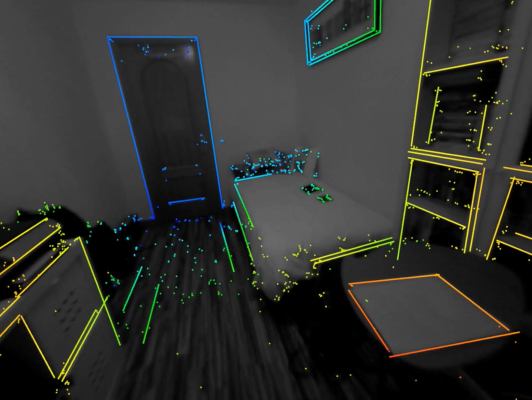Some of the most annoying parts of today’s virtual reality hardware are all the wires and the sensors needed to accurately track the headset. With all-in-ones, all of that hardware has to find its way into the headset and track your location in a low-power way.
Today, Occipital is showing off a tracking platform optimized for all-in-one headsets that will allow users to traverse spaces without external sensors using low-cost integrated cameras and IMUs.
With this effort, the company is aiming to achieve SteamVR-level accuracy — currently the gold-standard in VR tracking — to inside-out system using the technologies its spent nearly the past decade working on.
Occipital, which already sells a $349 depth sensing camera, acknowledges that in some ways it might be seen as “eating its own lunch,” but sees inside-out tracking on consumer devices as a future it wants to be a huge part of. Last year the company introduced Bridge, a $399 iPhone-based mixed reality headset dev kit built on the company’s depth sensor.
For a lot of device manufacturers the multi-camera sensor rigs are one of the more costly individual parts of their setup. With Occipital’s platform, developers can make due on a lot less.
What’s perhaps most notable is that they’re opening up their six-degree-of-freedom platform for free to hardware developers operating on less than 10,000 consumer devices, with pricing moving up from there for bigger clients.
Further interesting is the platform’s capabilities in regard to monoSLAM, or single-camera tracking and mapping. With a cheap ($5-10) wide-angle camera and a cheap IMU, Occipital has built a platform allowing VR hardware manufacturers the opportunity to build simple and effective inside-out tracking into their headsets.
I demoed the software using a single-camera and IMU solution attached to the front of an HTC Vive, and, even without SteamVR base stations in the room, the cheap camera built up a point cloud of the space while defining the lines and edges of surfaces around me. Despite a good deal of sudden shifting, the tracking system did a remarkably good job at staying stable.
The company still says that when it comes to tracking, the more cameras, the better, but this represents a real shot at making a single camera and IMU get all the heavy-lifting done. The company is focusing their efforts on all-in-ones but isn’t looking to smartphone-based mobile VR at the moment, though they didn’t rule out the possibility either.
The video below gives a good impression about what a single camera setup would look like on the company’s tracking platform.
General disclaimer that my experiences took place in a demo environment that was optimized for things to go well, but even so a lot of companies have built all-in-one tracking demos for particular scenarios that have gone quite awry.
The company says this entire platform isn’t a step away from hardware as much as it is the startup showing off some of the tracking wits that it’s dedicated so much of its engineering towards figuring out. All-in-one headsets seems to be a future that companies like Google, Facebook and Microsoft all expect, so with this move it seems Occipital is in good company.
The company is launching the platform with Android and Windows support; sign-ups are live now for dev kits.
